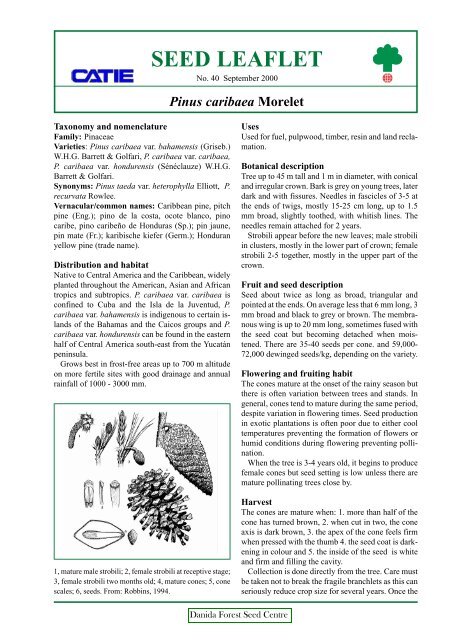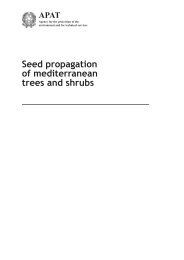Pinus caribaea
Pinus caribaea
Pinus caribaea
Create successful ePaper yourself
Turn your PDF publications into a flip-book with our unique Google optimized e-Paper software.
Taxonomy and nomenclature<br />
Family: Pinaceae<br />
Varieties: <strong>Pinus</strong> <strong>caribaea</strong> var. bahamensis (Griseb.)<br />
W.H.G. Barrett & Golfari, P. <strong>caribaea</strong> var. <strong>caribaea</strong>,<br />
P. <strong>caribaea</strong> var. hondurensis (Sénéclauze) W.H.G.<br />
Barrett & Golfari.<br />
Synonyms: <strong>Pinus</strong> taeda var. heterophylla Elliott, P.<br />
recurvata Rowlee.<br />
Vernacular/common names: Caribbean pine, pitch<br />
pine (Eng.); pino de la costa, ocote blanco, pino<br />
caribe, pino caribeño de Honduras (Sp.); pin jaune,<br />
pin mate (Fr.); karibische kiefer (Germ.); Honduran<br />
yellow pine (trade name).<br />
Distribution and habitat<br />
Native to Central America and the Caribbean, widely<br />
planted throughout the American, Asian and African<br />
tropics and subtropics. P. <strong>caribaea</strong> var. <strong>caribaea</strong> is<br />
confined to Cuba and the Isla de la Juventud, P.<br />
<strong>caribaea</strong> var. bahamensis is indigenous to certain islands<br />
of the Bahamas and the Caicos groups and P.<br />
<strong>caribaea</strong> var. hondurensis can be found in the eastern<br />
half of Central America south-east from the Yucatán<br />
peninsula.<br />
Grows best in frost-free areas up to 700 m altitude<br />
on more fertile sites with good drainage and annual<br />
rainfall of 1000 - 3000 mm.<br />
1, mature male strobili; 2, female strobili at receptive stage;<br />
3, female strobili two months old; 4, mature cones; 5, cone<br />
scales; 6, seeds. From: Robbins, 1994.<br />
SEED LEAFLET<br />
No. 40 September 2000<br />
<strong>Pinus</strong> <strong>caribaea</strong> Morelet<br />
Danida Forest Seed Centre<br />
Uses<br />
Used for fuel, pulpwood, timber, resin and land reclamation.<br />
Botanical description<br />
Tree up to 45 m tall and 1 m in diameter, with conical<br />
and irregular crown. Bark is grey on young trees, later<br />
dark and with fissures. Needles in fascicles of 3-5 at<br />
the ends of twigs, mostly 15-25 cm long, up to 1.5<br />
mm broad, slightly toothed, with whitish lines. The<br />
needles remain attached for 2 years.<br />
Strobili appear before the new leaves; male strobili<br />
in clusters, mostly in the lower part of crown; female<br />
strobili 2-5 together, mostly in the upper part of the<br />
crown.<br />
Fruit and seed description<br />
Seed about twice as long as broad, triangular and<br />
pointed at the ends. On average less that 6 mm long, 3<br />
mm broad and black to grey or brown. The membranous<br />
wing is up to 20 mm long, sometimes fused with<br />
the seed coat but becoming detached when moistened.<br />
There are 35-40 seeds per cone. and 59,000-<br />
72,000 dewinged seeds/kg, depending on the variety.<br />
Flowering and fruiting habit<br />
The cones mature at the onset of the rainy season but<br />
there is often variation between trees and stands. In<br />
general, cones tend to mature during the same period,<br />
despite variation in flowering times. Seed production<br />
in exotic plantations is often poor due to either cool<br />
temperatures preventing the formation of flowers or<br />
humid conditions during flowering preventing pollination.<br />
When the tree is 3-4 years old, it begins to produce<br />
female cones but seed setting is low unless there are<br />
mature pollinating trees close by.<br />
Harvest<br />
The cones are mature when: 1. more than half of the<br />
cone has turned brown, 2. when cut in two, the cone<br />
axis is dark brown, 3. the apex of the cone feels firm<br />
when pressed with the thumb 4. the seed coat is darkening<br />
in colour and 5. the inside of the seed is white<br />
and firm and filling the cavity.<br />
Collection is done directly from the tree. Care must<br />
be taken not to break the fragile branchlets as this can<br />
seriously reduce crop size for several years. Once the
cones have become brown and are still moist, the<br />
scales may start to open and pregermination occur. A<br />
cutting test will reveal this.<br />
Processing and handling<br />
After harvest the cones should not be left in sacks for<br />
more than 1-2 days and always in a cool, dry and<br />
properly ventilated place. Before drying, the cones<br />
are precured on trays with wire mesh, under shade,<br />
until the cone has turned completely brown (5-10<br />
days). After precuring, the cones open relatively easily<br />
and sun drying is normally adequate, provided the<br />
climate is not too humid.<br />
When the seeds have been extracted they are<br />
dewinged and cleaned and then dried in the sun on a<br />
sheet and raked frequently. The seeds will lose about<br />
1-1.5 % moisture per hour. Cleaning the seed before<br />
sowing to eliminate empty and dead seed can<br />
improve germination considerably.<br />
Storage and viability<br />
The seed is orthodox and can be stored at temperatures<br />
below 0°C. At 6-8% mc and 3-4° C in airtight<br />
containers, the seed can be stored for at least 5 years<br />
with little loss in viability. At room temperature, few<br />
seeds will survive one year of storage. As long as the<br />
seed is kept dry and cool, fumigation and application<br />
of fungicides are not necessary and may be harmful.<br />
Dormancy and pretreatment<br />
The seeds are not dormant, but in some places it is<br />
practice to soak the seeds in clean water for 12 hours<br />
followed by 2-3 days cold stratification at 4-5°C to<br />
obtain a more uniform germination.<br />
Sowing and germination<br />
Germination normally begins seven days after sowing<br />
and after 12-15 days reaches some 80%. The seeds can<br />
be sown directly in plastic bags with 1-2 seeds per bag,<br />
or in germination trays from where they are transplanted<br />
into bags when they are 3-4 cm long.<br />
Mycorrhiza is necessary for the sapling growth, and<br />
soil taken near established trees should be added. Suitable<br />
sowing medium is sand:forest soil in a 3:1 ratio. If<br />
the seedbeds are covered with mulch, it reduces the<br />
risk of fungi.<br />
Phytosanitary problems<br />
Cones that are inadequately stored are easily susceptible<br />
to infestation by fungal moulds, which may<br />
cause problems during germination. Infestation by<br />
pathogenic fungi may also happen especially in seed<br />
from high rainfall areas.<br />
Selected readings<br />
Birks, J.S., Barnes, R.D., 1990. Provenance variation in<br />
<strong>Pinus</strong> <strong>caribaea</strong>, P. oocarpa and P. patula ssp. tecunumanii.<br />
Tropical Forestry Papers, No. 21. Oxford Forestry Institute,<br />
University of Oxford.<br />
CATIE 1991. Pino Caribe, <strong>Pinus</strong> <strong>caribaea</strong>, Especies de<br />
árbol de uso múltiple en América Central. Turrialba<br />
(C:R:). Coleccíon guías silviculturales no. 8, 59 pp.<br />
Dvorak, W.S., Ross, K.D., Liu, Y., 1993. Performance of<br />
<strong>Pinus</strong> <strong>caribaea</strong> var. hondurensis in Brazil, Colombia and<br />
Venezuela. CAMCORE Bulletin on Tropical Forestry, No.<br />
11, 47 pp.<br />
Lamb, A.F.A., 1973. Fast growing timber trees of the lowland<br />
tropics. No. 6. <strong>Pinus</strong> <strong>caribaea</strong>, vol. 1. Commonwealth<br />
Forestry Institute, 254 pp.<br />
Napier, I.A. & Willan, R.L. 1983. Nursery Techniques for<br />
Tropical and Subtropical Pines. DFSC Tecnical Note No. 4.<br />
Soerianegara, I., Lemmens, R.H.M.J., eds., 1993. Plant<br />
Resources of South-East Asia No. 5(1). Timber trees: major<br />
commercial timbers. Wageningen, Netherlands: Pudoc Scientific<br />
Publishers. 610 pp.<br />
Robbins, A.M.J. 1994. <strong>Pinus</strong> <strong>caribaea</strong>. Seed Leaflet No.<br />
2. DFSC<br />
P. <strong>caribaea</strong> var. hondurensis. Alamikamba, Nicaragua.<br />
Photo: E.A. Gutierrez, CAMCORE.<br />
THIS NOTE WAS PREPARED IN COLLABORATION<br />
WITH CENTRO AGRONÓMICO TROPICAL DE<br />
INVESTIGACIÓN Y ENSEÑANZA<br />
Authors: Rodolfo Salazar, CATIE<br />
Dorthe Jøker, DFSC<br />
Danida Forest Seed Centre Phone: +45-49190500<br />
Krogerupvej 21 Fax: +45-49160258<br />
DK-3050 Humlebaek Email: dfsc@sns.dk<br />
Denmark Website: www.dfsc.dk




